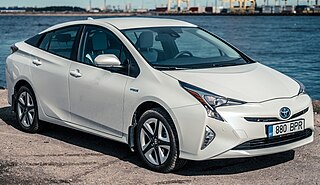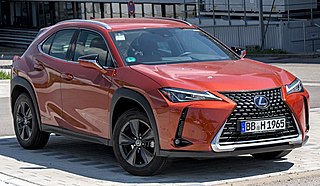
The Toyota Prius is a compact/small family liftback produced by Toyota. The Prius has a hybrid drivetrain, combined with an internal combustion engine and an electric motor. Initially offered as a four-door sedan, it has been produced only as a five-door liftback since 2003.

The Lexus GS is an executive car manufactured and marketed by Lexus across four generations — launched in 1991 as the Toyota Aristo in Japan and as the Lexus GS for markets outside the Japanese market beginning in February 1993. It continued with the Toyota Aristo name for the Japanese market until January 2005.

The Toyota RAV4 is a compact crossover SUV produced by the Japanese automobile manufacturer Toyota. It is known for starting the wave of compact crossovers. The RAV4 is one of the best-selling SUVs of all time. By February 2020, a total of 10 million RAV4s had been sold globally.

The Lexus LX is a full-size luxury SUV sold by Lexus, a luxury division of Toyota since January 1996, having entered manufacturing in November 1995. It is Lexus' largest and most expensive luxury SUV. Four generations have been produced, all based heavily on the long-running Toyota Land Cruiser SUVs. The first-generation LX 450 started production in 1995 as Lexus' first entry into the SUV market. Its successor, the LX 470, premiered in 1998 and was manufactured until 2007. The third-generation LX debuted at the New York International Auto Show in April 2007. The fourth-generation LX debuted in October 2021.

Steer-by-wire, in the context of the automotive industry, is a technology or system that allows steering some or all of a vehicle's wheels without a steering column that turns the direction of those wheels mechanically. It is different from electric power steering or power-assist, as those systems still rely on the steering column to transfer some steering torque to the wheels. It is often associated with other drive by wire technologies.

Toyota Motor Europe (TME) is a subsidiary of Toyota Motor Corporation, overseeing operations across Europe and Western Asia, including Turkey, Russia, Israel, Kazakhstan, and the Caucasus. TME’s activities encompass research and development, manufacturing, sales, marketing, after-sales, and various corporate functions. Headquartered in Brussels, Belgium, TME commenced operations in 1963.

The Lexus CT is a hybrid electric automobile sold by Lexus, a luxury division of Toyota, as a premium compact hatchback. The CT, consisting of a single model called the CT 200h, is a luxury hybrid based on the Toyota Prius drivetrain and Toyota MC platform chassis, and is the first luxury compact and hatchback hybrid. It is the first production model in Lexus's family to introduce the "Spindle Grille" design as seen in its fascia. It made its debut at the March 2010 Geneva International Motor Show, six months after the unveiling of the LF-Ch concept car; it is primarily targeted at the European market but is being sold worldwide and was introduced to North American markets at the April 2010 New York International Auto Show. Lexus has trademarked the names CT 200h, CT 300h, and CT 400h. The design by Takeshi Tanabe was approved in 2008 and patented on 11 September 2009.

The Lexus RX is a luxury crossover SUV sold since 1998 by Lexus, a luxury division of Toyota. Originally released in its home market of Japan in late 1997 as the Toyota Harrier, export sales began in March 1998 as the Lexus RX.

The Lexus RC is a compact executive two-door sport coupé manufactured by Lexus, Toyota's luxury division. The RC which according to Lexus stands for "Radical Coupe" is a two-door coupé version of the Lexus IS (XE30). The RC is designated as the XC10 series. The RC borrowed styling from the LF-LC concept and was previewed by the LF-CC concept, being designed as a proposal by Pansoo Kwon from 2010 to early 2012 and approved by supervising designers Yasuo Kajino and Tatsuya Takei.

The Lexus NX is a compact luxury crossover SUV sold by Lexus, a luxury division of Toyota. Introduced in late 2014, it is positioned between the subcompact UX and the mid-size RX in Lexus’ crossover SUV lineup.

The Toyota New Global Architecture is a modular automobile platform that underpins various Toyota and Lexus models, starting with the fourth-generation Prius in late 2015. TNGA platforms accommodate different vehicle sizes and also front-, rear-, and all-wheel drive configurations.

The Toyota C-HR is a subcompact crossover SUV manufactured and marketed by Japanese automaker Toyota since 2016. The development of the car began in 2013, led by Toyota chief engineer Hiroyuki Koba, sharing the TNGA-C (GA-C) platform with the E210 series Corolla and positioned between the Yaris Cross and Corolla Cross in Toyota's crossover SUV range.

The Lexus UX is a subcompact luxury crossover SUV from Lexus, a luxury division of Toyota. It was introduced at the March 2018 Geneva Motor Show as the smallest crossover model in Lexus' lineup prior to the introduction of LBX in 2023, it is currently slotted above the subcompact LBX and below the compact NX. It is also the first Lexus model based on the same GA-C platform as the E210 series Toyota Corolla. The "UX" name stands for "Urban Explorer".

The Mazda CX-30 is a subcompact crossover SUV produced by Mazda. Based on the fourth-generation Mazda3, it debuted at the 2019 Geneva Motor Show, to slot in between the CX-3 and the CX-5. It went on sale in Japan on 24 October 2019, with global units being produced at Mazda's Hiroshima factory, North and South American units built in Salamanca, Guanajuato, Mexico, Thailand and initial Australian units made at the AutoAlliance Thailand plant in Rayong, and China-market units produced in Nanjing by Changan Mazda.
This is a list of concept vehicles made by Toyota from the years 2020–2029.
Toyota Motor Kyushu (TMK) is a manufacturing subsidiary of Toyota established in 1991 and focused on the production of Lexus cars, engines, and hybrid systems. Its headquarters and single assembly plant are in the city of Miyawaka in Japan's Fukuoka Prefecture. Car production started in December 1992.

The Toyota bZ4X, also marketed in Japan, Australia, US, Canada, Europe, and China as the Subaru Solterra, is a battery electric compact crossover SUV manufactured by Toyota. The vehicle debuted in April 2021 as the "bZ4X Concept". It is the first vehicle to be based on the e-TNGA platform co-developed by Toyota and Subaru, and the brand's first model to be part of their Toyota bZ series of zero-emissions vehicles.
The Toyota bZ series is a family of battery electric vehicles (BEV) manufactured by Toyota. It was introduced in April 2021 alongside the bZ4X Concept. The bZ series is a part of Toyota's plan to introduce 15 battery electric vehicle models by 2025, seven of which are from the bZ series. Vehicles from the bZ series make use of the e-TNGA platform co-developed with Subaru.
BluE Nexus is a joint venture company established by Aisin and Denso in April 2019 to build powertrain systems for electric vehicles. Both Aisin and Denso are members of the Toyota Group and the Toyota Motor Corporation has a 10% stake in the company.

The Lexus LBX is a subcompact luxury crossover SUV (B-segment) marketed by Lexus, a luxury division of Toyota. Primarily developed for Europe and Japan, it was introduced in June 2023 in Milan, Italy as the smallest crossover model in Lexus' lineup, slotting below the C-segment UX. It is also the first Lexus model based on the Toyota TNGA-B platform, which is shared with the XP210 series Toyota Yaris Cross and the XP210 series Toyota Yaris. It entered production by the end of 2023 and went on sale in Europe along with additional markets in early 2024.

















